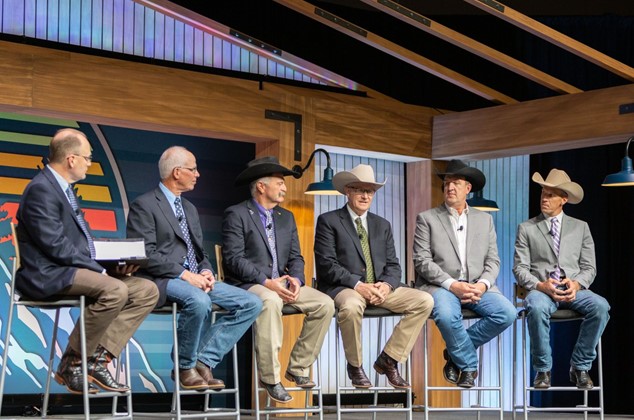Perspectives from all sectors were discussed in the panel at the 2022 Angus Convention

Cattlemen and women from across the United States work in different sectors of the beef industry, deal with different environmental issues and have different business strategies. But at the end of the day, all farmers and ranchers work toward the same goal; to continue raising and selling the best beef possible.
Raising top-quality beef comes with both barriers and optimism. During the 2022 Angus Convention first general session, Exploring Your Potential, five Angus breeders and industry experts spoke on a panel with Mark McCully, American Angus Association® chief executive officer, as the moderator. The panel took place November 5 in Salt Lake City, Utah.
The panel included the following backgrounds and perspectives: Jerry Connealy with Connealy Angus; Mark Gardiner with Gardiner Angus Ranch and U. S. Premium Beef; Ed Greiman with Greiman Brothers and Upper Iowa Beef; Joe Goggins with Vermillion Ranch and Northern Livestock Video Auction; and Matt Perrier with Dalebanks Angus.
Big opportunities lie ahead for the industry, the panelists said. Perrier spoke about the importance of influence and the next generation. Greiman discussed how vital it is for producers to continually improve quality so packers can find new ways to add value to the carcass. The type of supplies and increasing packing capacity brought excitement to Goggins, and Connealy shared his perspective about the value of Association tools.
“It’s full circle. The American Angus Association provides the tools, and you guys [producers] have obviously done a tremendous job using those tools making a premium as demand has gone up,” said Connealy. “But there is still upside that we can get better. We can always get better.”
Vertical coordination is also an answer to improving the beef industry while avoiding vertical integration said Gardiner. He defines vertical integration as an entity owning things from the cut of beef all the way to the genetics.
“The only way we keep that from happening, in my opinion, is through vertical coordination and passing that information, building those alliances, sharing and being transparent with whoever it is we sell product to and with who they sell product to,” said Gardiner.
Perhaps the biggest challenge, the cattlemen said, is ensuring that beef industry profitability is spread over all segments of the industry. In the past, when one segment made money, the others lost it —the “skin thy neighbor approach,” as Gardiner put it.
The panelists talked about the value and quality of Angus beef creating more profitability. Perrier mentioned a quote from John Stika, Certified Angus Beef® president, who said the only new money in the beef industry comes from the consumer. If that is the case, we must ensure there is opportunity to make money through consumer demand, said Perrier.
Increasing consumer demand also means increasing consumer trust, which Connealy said is the most significant barrier to the industry’s future success. If we don’t do the right things, or represent our cattle and our industry correctly, consumer trust could drag us down, he said.
Pull-through demand for Certified Angus Beef® is key. As long as we can keep that, he said, “We will come out on top. I am confident in that.”
The group’s morale was bullish as they considered environmental and economic factors influencing profitability of producers in the coming years. Considering the market’s improvement and opportunity, the group also recognized the effect rising input costs will have on cattle prices. Greiman discussed how producers should use the tools and resources available to them as prices swing. Risk management was a tool discussed as well as a genetic hedge—or the ability to protect yourself through the use of good genetics.
The Angus breed is positioned well to help with that, Perrier said. “We have one breed that can do what we do from an end product, growth standpoint and yet still have a pasture full of females that are going to make the producer money.”
As the Angus breed and beef industry work toward a successful future, the panel reminded attendees how everyone is facing the same challenges and opportunities. Regardless of size and shape, there is room for success and probability of cattle producers.
For news about Angus Convention, visit www.angus.org/Pub/NewsRoomReleaseList.
- Written by Whitney Whitaker, Angus Communications















